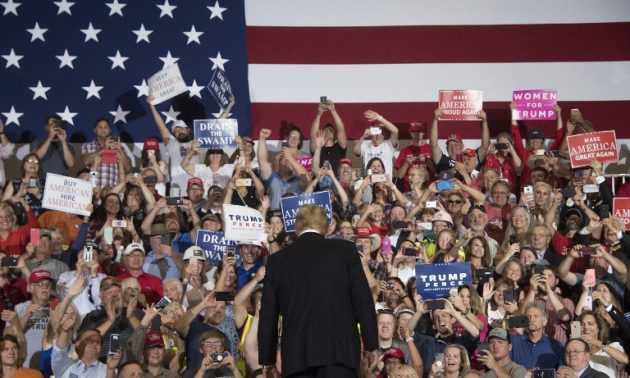Washington’s free traders held hostage by Trump’s plan for midterms
14 July, 2018

“I want tariffs… I want someone to bring me some tariffs.”
This is the scene in the White House one year ago. US President Donald Trump is in the Oval Office fuming to his chief of staff John Kelly.
“John, you haven’t been in a trade discussion before, so I want to share with you my views. For the last six months, this same group of geniuses comes in here all the time and I tell them, ‘Tariffs. I want tariffs’,” Trump said, according to an account published last year by Axios.
“Let me tell you why they didn’t bring me any tariffs,” Trump was quoted as saying. “I know there are some people in the room right now that are upset. I know there are some globalists in the room right now. And they don’t want them, John, they don’t want the tariffs. But I’m telling you, I want tariffs.”
Many observers who have watched Trump for decades warned throughout his first year in office that he might actually follow through with threats to enact protectionist measures, which he repeated ad nauseam during his election campaign. Nonetheless, for a long time, all was quiet on the trade front.
Those days now feel like a distant memory. Administration officials have dutifully brought the president the tariffs he so wanted, and far from dealing a blow to markets, the economy and the president’s poll numbers, the ensuing developments – so far – have actually created momentum for Trump to double down on the policy.
To recap, Trump first dipped his toe in the pool of protectionism with an inconsequential move targeting foreign-made washing machines and solar panels. The tariffs had no material impact, even on some of the firms directly targeted, but the president received a tongue-lashing from the news media, as well as from advocates of free trade in Congress from both political parties.
Far from being dissuaded, Trump upped the ante and announced steep tariffs on foreign-made steel and aluminum. This time, the market responded, but then recovered. In a week when Mexico, Canada and the European Union all imposed retaliatory tariffs, US stocks gained.
In the same week, the US imposed tariffs on US$34 billion in Chinese goods, to which China responded. Trump then announced he would slap tariffs on an additional US$200 billion in imports from China. Stocks rose again.
Meanwhile, despite some skepticism from economists about medium- and long-term prospects, economic data coming out of the US has been painting a rosy picture.
To top it off, the president’s poll numbers continue to rise. All three things that critics of Trump’s trade policy had hoped would force him to back off – markets, the economy and politics – have done the opposite.
This is coming during a midterm election year which will decide whether the president’s party maintains majority control of Congress. The stakes are high. While the Republicans are unlikely to lose their grip on the Senate, the House of Representatives should be the Democrats’ for the taking. Conventional wisdom says that the president’s party loses seats during midterm elections, and the Democrats have maintained a lead in generic-ballot polling.
If the Democrats win back the House they can unleash an unrelenting barrage of investigations into Trump administration officials, tying up the White House with an endless string of subpoenas for documents and appearances at congressional hearings. But despite Democrats once-brimming confidence that a “blue wave” would sweep them into control of the House, their excitement diminishes by the day.
The politics of Trump’s trade war are somewhat contradictory. Polls show that a majority of Americans are wary of tariffs, and understand them to be harmful to the economy and their pocketbooks.
Several factors complicate the political calculus surrounding Trump’s tariff policy. For one, retaliatory tariffs slapped on US goods disproportionately affect voters in states where Trump has the strongest support. This was by no accident, designed to put political pressure on the president.
A closer look at the nature of today’s American politics shows that such a strategy may be ineffective. Trump’s popularity among his base, and the country’s heightened partisanship, mean that some who would be negatively affected by his trade policy still would be reluctant to defect. Tariffs are unlikely to have a dramatic impact on the average voter by the time they head to the polls in November, and other issues, such as the economy, tax cuts and immigration, will take precedence.
While the agricultural industry, among others, is already feeling the pain of retaliatory tariffs, Trump may be banking on overperforming in the rust belt states that helped him win his presidential election. His campaign strategy in former manufacturing hubs was successful in peeling off voters who traditionally cast ballots for Democrats, precisely because of his proposals for protectionist policies. In fact, in a recent House special election, a Democratic candidate was able to pull off an upset victory by supporting Trump’s tariff policies.
Currently, bipartisan efforts to crimp Trump’s power to impose tariffs without congressional oversight are taking shape. But, despite the overwhelming passage 88-11 of a symbolic motion on Wednesday reaffirming Congress’ role in trade, Republicans are afraid to even put a binding bill up for a vote, as Senator Jeff Flake lamented this week.
“If we had had a binding vote today, we wouldn’t have won it,” Flake, one of the most outspoken Republican critics of Trump, was quoted as saying after the vote on Wednesday.
“Some are still giving the president some kind of license or leash here. But most of us think we know where the president wants to go. And it’s not where we want to be,” he added.
TAG(s):
